
KNOWLE LOCAL HISTORY SOCIETY
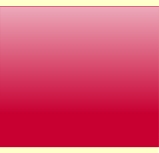
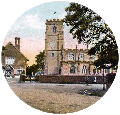

The Red Lion
The Red Lion probably dates from the early 17th century. A section of the original
wattle and daub construction can be seen high up on the south wall. Inside, there
is an original 17th century fireplace in the public bar and a cruck beam on the first
floor. There is no pictorial record of the timber framing on the front of the building,
as the facade was plastered over during the Georgian era. Early photographs show
a much larger range of outbuildings than exist today. In the early 20th century
the Red Lion consisted of a public bar, tap room and parlour, with flagstones throughout
the ground floor. The assembly room was on the ground floor at right angles to the
front of the building, along the wall between what is now Eric Lyons' butcher's shop
and the car park where the kitchen is now. There were harness rooms at the back
and a pump in the yard outside the kitchen door. There were two staircases. The
bedrooms still had the original timber floors -
When Ansells Brewery took over the inn from Lucas's of Leamington Spa in 1935 it was extensively restored: the rendering on the frontage was replaced with the mock Tudor timbering still there today, and several smaller rooms were made into a lounge bar. Fortunately, the fine old burnished steel fireplace from the public bar, which bears the date 1779 stamped on the urns at each end, survived the alterations. At the same time a small piece the original wattle and daub was exposed to view on the first floor of the south side, near the entrance to the car park. In recent years there have been various refurbishments: the ground floor is now completely open plan, with the original cosy small rooms transformed into nooks and alcoves.
Perhaps the most famous event which took place in the Red Lion yard was the visit of John Wesley in 1749. He didn’t have much luck and found it a ‘furious turbulent place’ from the start, although to begin with things went reasonably well, with a tolerably attentive gaping crowd. In the first half of the 20th century Knowle had its own fire engine, housed in the Red Lion outbuildings. The crew were local. When the alarm was raised the arrangement was that the men would assemble at the Lion, where there was time for a few pints before attending to the fire. This may have lost nothing in the telling.
At the rear there used to be a crown bowling green, laid by Ansells in 1948 to replace one lost when the White Swan was demolished. It was used by Ye Olde Knowle Bowling Club (founded c.1768) until it closed in the 1990s. The club, still thriving, now plays on a new green near The Railway Inn at Dorridge.
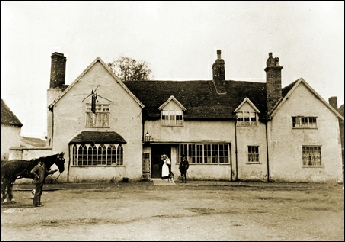
The Red Lion c. 1900
The fireplace, 2002
Like all pubs the Red Lion had its social side. Apart from the informal gatherings
of villagers dropping in for a drink and a smoke and a chat there were organized
events and a number of red letter days. in the mid 19th century there appears to
have been an annual ball: a gentleman’s ticket (which may have included a lady) cost
6s 6d (32p). In 1868 it was held in early January, presumably for the New Year.
One big event for the Red Lion in the early 20th century was Warwick Race Day, with
throngs of people refreshing themselves en route for Warwick and returning race-
Several organizations met at the Red Lion, including The Royal and Ancient Order of Buffaloes (The ‘Buffs’), Knowle British Legion and Knowle Association for the Prosecution of Offenders (more commonly known as The Felons), an organisation formed by local residents about 1800 to secure the apprehension of felons.
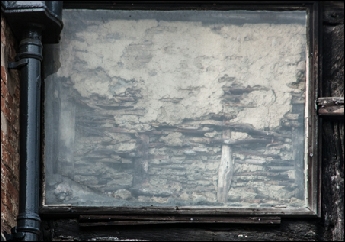
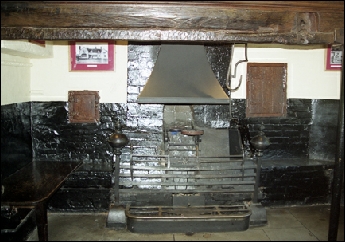
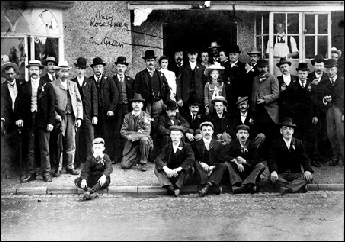
Wattle & daub infill high up on the south wall.
The Red Lion, 2002
An outing from the Red Lion in 1908.
Warwick Race Day, c. 1900. Note the number of outbuildings.
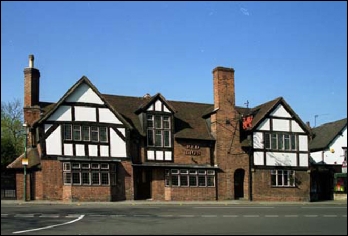
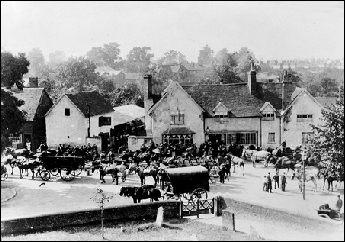
| The Church |
| The Guild House |
| The Red Lion |
| Paterson Court (Old School) |
| Milverton Farm (Petrol Station) |
| Kixley Lane Cottages |
| Far End & The Cottage |
| Milverton House & Milverton Crescent |
| Berrow Cottage Homes |
| Wilsons Row |
| Knowle Library (Chester House) |
| Greswolde Arms Hotel |
| Grimshaw Hall 1560 - 1765 |
| Grimshaw Hall After 1765 |
| Malthouse Row (Nos 19 to 25) |
| Eastcote Ford |
| The Wilson Arms |
| Artillery Cottages |
| Knowle Lodge (Knowle Surgery) |
| Jobs Close |
| The Olde House |
| Knowle Picture Playhouse (Johnsons Cars) |